St Benet’s Paul’s Wharf (St Benet’s Welsh Church)
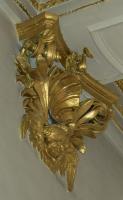
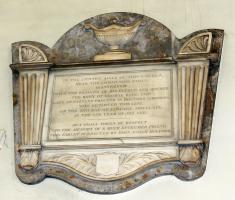
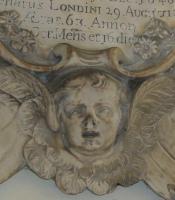
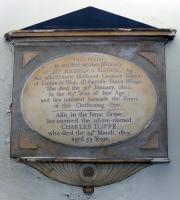
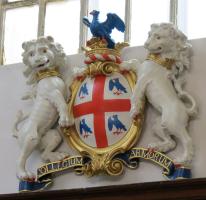
The Church of St Benet, sometimes spelt as St Bennet’s, and derived of course from St Benedict’s, is today the City's Welsh Church. It stands just to the side of
Queen Victoria Street, towards Upper Thames Street, and is a work of Christopher Wren, replacing a medieval church
destroyed in the Fire of London. Some remnants of the walls apparently survive in the core of the current building,
which was put up between 1677 and 1685. Wren's mason for this church was Edward Strong.
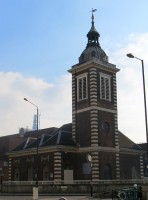
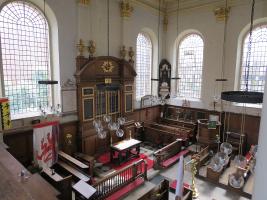
St Benet Paul's Wharf (St Benet Welsh Church).
St Benet's as we see it today is built of darkened red brick with edges, corners and window surrounds of
Portland Stone. From the outside, it is notable for its short square tower, rather stripy, with lead-covered steeple above,
and also for its relatively large arched windows. It is rather small, rather square, though this is more noticeable from the
inside than the outside. Above each of the windows is a complicated carved festoon of fruits and flowers, 10 in all, similar in overall shape from one to the next, but each with different component vegetation, and replacing close study. On the south side, one of the festoons also contains a chubby cherubic head with wings. At the end of the 19th Century this little church passed to the Welsh Church.
Inside, the church is rather cubical, with Corinthian flat pilasters, much by way of brown wood fittings, and galleries to the north
and west sides. There are also cherubic heads, gilded, at the tops of the walls. All this is largely unaltered, so that St Benet's looks much as it was intended to look like when it was first built by Wren.
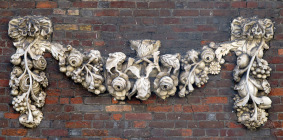
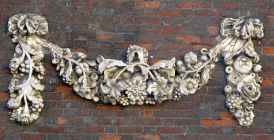
Two of the festoons on St Benet's.
Monuments:
The Pre-Fire Church contained a monument to Chief Justice Sir William Cheyny [Cheney], knight, and his wife Margaret,
d.1442, and a variety of monuments from the 16th Century, including Sir Richard Caldwell, d.1585, and of particular interest to
these pages, the architect Inigo Jones. d.1652, a white marble monument (the 19th Century monument to him is noted below), as
well as two embroiderers to Queen Elizabeth,
but none of these survived the 1666 Fire. The monuments which exist today include a variety of mostly modest wall panels
dating from 1684 when the church was not yet quite complete, through to the majority which date from the early
19th Century, through to three late 20th Century memorials. The more elaborate panels are generally the earliest.
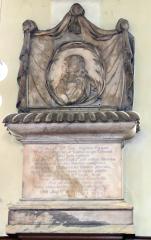
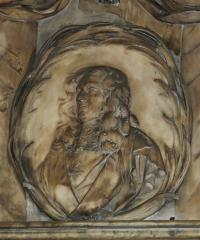 Baronet Sir Robert Wyseman, d.1684
Baronet Sir Robert Wyseman, d.1684
- Sir Robert Wyseman, Bt, d.1684, with a Latin inscription on a panel, heavy base and upper gadrooned (corrugated) shelf,
the whole forming a short plinth to an upper section, carved as a shroud, knotted at sides and centre,
on which is a roundel with a portrait of the deceased. An excellent piece, the weight and solidity of the carving
being appropriate for the size of the work, the whole in a characterful streaky marble. The portrait is also excellent -
a rather solid-faced man, given a look of pride and dignity, a stern man, with flowing locks of hair or wig, his throat
covered by an ornate carved high collar, his chest within a heavy robe. Pevsner, the architectural historian, notes that the
monument has been attributed to Grinling Gibbons, and the bust to Arnold Quellin.
- Stephen Brice, d.1688, of Whitney Park, near Oxford, with a Latin inscription, cut in a black stone oval panel.
The elaborately carved surround is in the form of a cartouche - a sculptural rather than architectural panel based on an oval. It features
hanging drapes, depending from a central pot high up, with a flame,
descending outwards to two upper corners which are tied, falling in graceful folds to lie upon the hair of two winged
cherub heads, then splaying out underneath. In front of this is a scrolly inner frame with a variety of acanthus leaves,
both scrolls and acanthus boldly and variously cut. A small cartouche surrounded by more acanthus at the bottom centre
would have contained a painted coat of arms presumably; below this, a final winged cherubic head. Asssured, superior work.
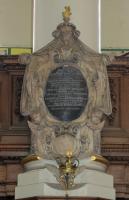

Cartouche monuments to Stephen Brice and Gregory King.
- Gregory King, d.1712, with a long inscription noting that he was ‘First Rouge Dragon Persuivant [an office in the College of Arms
named after the Welsh Dragon], afterwards
Lancasster Herald, and Sometime deputy Garter King of Armes, Secretary to ye Hon. Ye Commissioner for taking and
Staring the Publick Accompts of the Kingdom…’. ‘He was a Skilful herald, a good Accomptant Sureveyor, and Mathematician,
a Curious pen Man, and Well Cerit in Political Arithmetick…’ Another fine cartouche, with knotted drapes, swirls,
hanging drapery to form the apron, which bears a large winged cherub head, and above, a small shield of arms in a
secondary cartouche. The boldness of carving, particularly of the outer knots, gives a power to the composition.
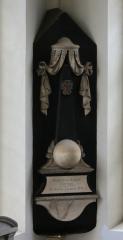 Strange monument to Marco and Alice Cottle.
Strange monument to Marco and Alice Cottle.
- Marco Cottle and Alice Cottle, with the obscure inscription ‘D Nath: Lloyd PV.’ underneath and no date,
but presumably 18th Century. A remarkable thing, with the inscription on the base of an obelisk, with a great sphere
studded into it. A small heraldic cartouche is attached near the top of the obelisk, and at the top, more conventionally,
is a knotted hanging drape depending from a small pavilion cover. All on a black base, angled to fit in the corner of
the wall.
- Arthur Collier, d.1777, carved in the form of a hanging shroud with tasselled edging,
hanging on pegs from the shelf of a concealed panel, with a coat of arms in the centre with ribbons above - see picture below left.
Nicely cut. Such hanging shroud panels were never very common, and seem to have been most usual earlier in the
18th Century.
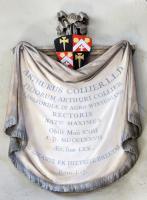
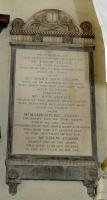 Late 18th Century: carved drape and Classical panel.
Late 18th Century: carved drape and Classical panel.
- John Charles Brooke, d.1794, with a long eulogy to this ‘Person of unrivalled Eminence’,
who was bereaved of these ‘sublunary blessings’ in the ‘dreadful Calamity which happened at the Theatre in Haymarket
on the third of February, 1794’ – the event referred to being when some of a crowd wishing to see the Royal Family,
who were visiting the theatre, were pushed down a steep staircase, with others falling down upon them, leading to 15
deaths. White panel on grey marble backing, with shelf and apron below, entablature and segmented pediment above
bearing a shield on two crossed palms, with little flowers to the sides and some broken piece on top which may be a heraldic crest,
the remnants of a flame from a lost pot, or something else.
- Trew Jegon, d.1799, wife Ann Jegon, d.1828, sons Trew, d.1864 and
Marmaduke, d.1861, and the latter’s wife Mary Ann, d.1825. Panel with narrow dark surround,
curved pediment above bearing carving of an open book resting on crossed palm leaves, roundels bearing flowers on the
sides acting as acroteria, two further flowers on the entablature – the piece as a whole is a more elaborate version
of the Brooke monument noted above. The narrow apron below has two more flowers above the narrow brackets, and is
prominently signed by the statuary, J. Simplon [?], who is obscure. See picture above right.
- John Hawkins Bankes, d.1800, mother Mary Bankes, d.1803, father John Bankes,
d.1809, and others of the family, plain white marble panel with thin red marble border - about as late as colour appeared in monuments
for almost the next century - a mildly carved lower sill,
brackets, and black curvy apron.
- William Sharpe, d.1801, wife Elizabeth, d.1802, sons William, d.1813 and
Thomas, d.1825, plain white marble panel on grey backing.
- Rebecca Iliffe, d.1802, and husband Charles Iliffe, d.1803, oval panel on a wide rectangular
backing, with raised spandrels at the corners, lightly incised, apron with further lines and simple central flower motif,
blank pediment cut out above in black, with shelf but no sides - see picture at top of page. Unusual.
- Alice Heard, d.1808, with short Latin inscription, yellowed marble panel with grey border.
- James Maclaren, d.1808, ‘late of Carron Warehouse in this Parish’ (see Duncan Maclaren below),
infant daughter Elizabeth, d.1808, and son Ambrose, d.1833 [?], and continuing on a second panel
below, eldest daughter Anne, d.18?? and second daughter Charlotte. All on worn rectangular
panels with no surviving border. The stonemason was T. Marsh of New Road, London. See picture below, second left.
- George Bogg, d.1813, the central panel having side pilasters or frame widening towards the top,
fluted and with acroteria at the top, a curvy apron below bearing a shield, now blank, and two ferny fronds, and above,
a broad funeral urn. The backing is of a fine grey brecciated marble with pinky-brown flecks. Again an unusual choice of coloured marble for this period.
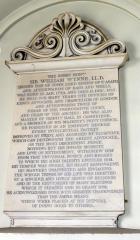
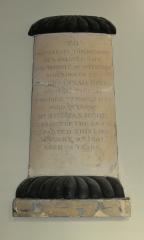
Sir William Wynne and Susannah Hood.
- Rt Hon. Sir William Wynne, d.1815, King’s Advocate, and Chancellor of London, Judge, etc etc,
with a long inscription in tightly packed capital letters, filling a rectangular panel with meagre base, protruding shelf
above, and an elegant semicircular pediment above, with deeply cut swirls, most harmonious.
- Catharine Robinson, d.1830, and husband Rt Hon Sir Christopher Robinson, d.1833,
plain panel with shield of arms above with a deer, and the motto ‘Watch’. See picture further down page, centre.
- Susannah Hood, d.1833, and husband Thomas Hood, d.1841, a short, stocky pillar shape with
top and base in black jelly mould design, unusual.
- James Farquhar, d.1833, an Aberdeen MP and doctor, white marble panel with heavy shelf/pediment
bearing shield at arms.
- John Hall, d.1835, and wife Ann, d.1837, plain.
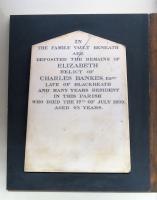
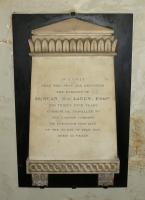
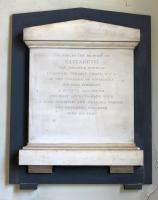
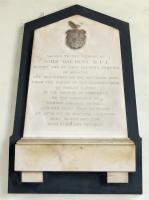
Typical white-on-black panels from the early 19th Century.
- Duncan Maclaren, d.1837, ‘commercial traveller to the Carron Company’
[a major Scottish ironworks during the Industrial Revolution and Victorian times which survived into the early 1980s
before being bought up by an international corporation]. White panel with upper and lower shelf bearing a carved design,
and acanthus leaves on the two brackets. Signed by T MARS[H], New Road, a sculptor whose several memorial tablets are
widespread in southern and middle England.
- Mary Moser[?], d.183[?]7, and Robert, d.1828, a very worn beige stone panel.
- Sir Ralph Bigland, d.1838, Knight Garter, and first wife Susan Elizabeth, and
William ? and daughter Anna Maria, d.1792, a worn monument in the shape of an exterior
tombstone. Second example, to John ????, very worn, also in the form of an exterior tombstone.
- Charlotte Eleanor Dalton, d.1838, plain with shelf above.
- Elizabeth Bankes, d.1839, white tombstone shape on black rectrangular backing - see picture above, left.
- I. M. Stephens, d.1841, and wife Harriot, d.1854, with upper shelf.
- Sir William Woods, d.1842, Garter Principal King of Arms, white marble tablet with pediment bearing
crowned circlet, once presumably enclosing a small shield of arms - picture below right.
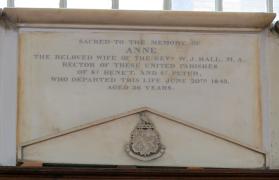
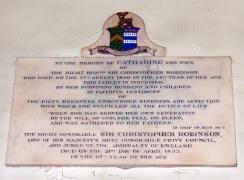
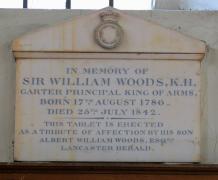
White horizontal panels, early 19th Century: Hall, Robinson, Woods.
- Anne Hall, d.1843, wife of the Rector, with shelf, and in front of it, pediment presumably
removed from the top (to not obscure the window) with a shield at arms surmounted by a bird, delicately carved - see picture above left.
- Elizabeth Pratt, d.1846, as a chest tomb end, rather chunky, on a black backing. See picture further up page, second right.
- John Daubeny, d.1847, descended from the family of the Hungerfords, of Farley Castle,
in the County of Somerset. Another typical tomb, with blocky base, damaged coat of arms in relief,
on a shaped black backing. See picture further up page, far right.
- Sherrard Beaumont Burnaby, d.1849, ‘Doctor of Laws’, and Vicar General to
his Grace the Archbishop of Canterbury, as a white marble tomb chest end, with heavy shelf above bearing a concave lid
with scrolls at the sides, on a shaped black backing. A small shield is on what passes for the apron.
- Enoch Jones, vicar until 1963, with brief Welsh inscription, with shelf.
- Gerald Cobb, d.1986, Ecclesiologist, Past Master of the Art Workers Guild, Herald Painter
at the College of Arms, Historian of the City of London. Oval of slate, finely cut.
- Sir Anthony Richard Wagner, d.1995, of the College of Arms etc etc, with long inscription,
rather cramped in the conscious fashion of the mid 17th C, on a fine sandy-coloured stone. Gilded and painted shield of
arms above.
Also, a panel to Inigo Jones, d.1651, with Latin inscription, a copy from his monument in the medieval
St Benet's church, recorded by direction of his descendent, Lieut. Col. Inigo Jones of Kelston, Somerset, d.1878.
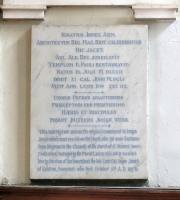 Inigo Jones text (click to enlarge).
Inigo Jones text (click to enlarge).
Also in the Church
Also in St Benet's Church, we may note:
- A coat of arms with two pleased looking lions and a phoenix, and the motto Collegium Armorum (College of the
Garter King of Arms). Painted, presumably wooden.
- Font, with a Doric vase-foot, and winged cherub heads and drapes etc on the outside of the bowl - picture below. Godwin, chronicler of
City Churches in the 19th Century, did not like it and wrote that it was ‘in bad taste and undeserving of notice’; an earlier writer
said that it was 'a Curious Marble Font adorned with Cherubims...'
- Communion table, 17th Century, with nice carving, and other 17th Century furnishings: stalls, lectern, reredos and part of the pulpit.
- WW1 memorial, with a horizontal panel between thick pilasters and with a segmental pediment above.
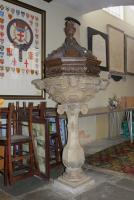
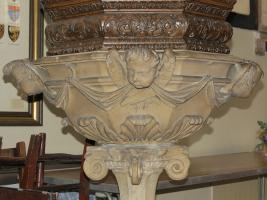
With thanks to the Church authorities for permission to show pictures from inside St Benet's: their website is
at http://www.stbenetwelshchurch.org.uk/pages/history1685ENG.html
Top of page
West to Victoria Embankment // West and South to Blackfriars Bridge //
West and North to St Martin's Ludgate // East to St James Garlickhythe
City Churches // Christopher Wren // London sculpture // Sculptors // Introduction to church monuments
Angel statues // Cherub sculpture
Home
Visits to this page from 13 Mar 2014: 9,323










 Baronet Sir Robert Wyseman, d.1684
Baronet Sir Robert Wyseman, d.1684



 Inigo Jones text (click to enlarge).
Inigo Jones text (click to enlarge).